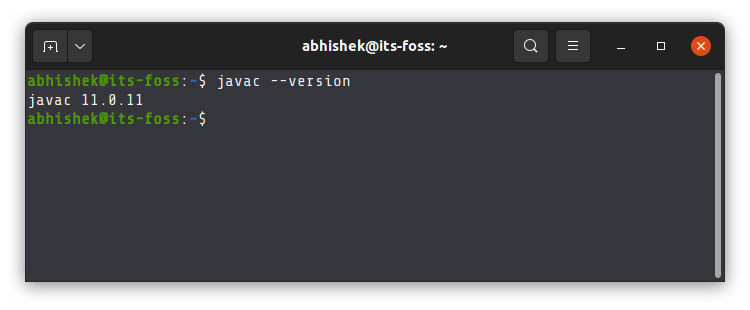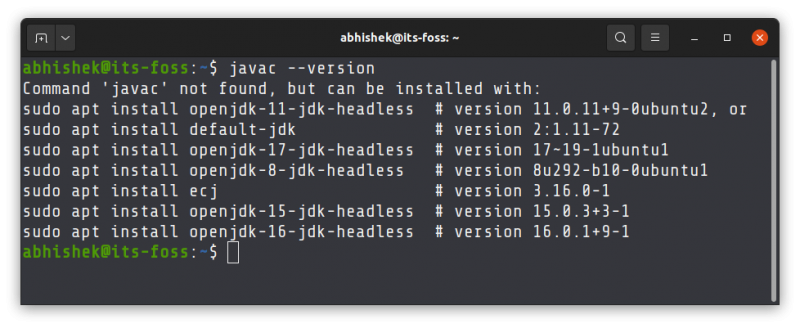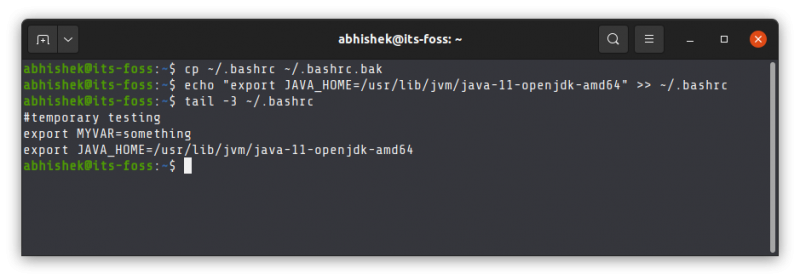How to Set JAVA_HOME Variable in Ubuntu Linux Correctly
If you are running Java programs on Ubuntu using Eclipse, Maven or Netbeans etc, you’ll need to set JAVA_HOME to your path. Otherwise, your system will complain that “java_home environment variable is not set”.
In this beginner’s tutorial, I’ll show the steps to correctly set Java Home variable on Ubuntu. The steps should be valid for most other Linux distributions as well.
The process consists of these steps:
- Making sure Java Development Kit (JDK) is installed.
- Finding the correct location of JDK executable.
- Setting the JAVA_HOME variable and making the change permanent.
Step 1: Check if JDK is installed
The simplest way to check if Java Development Kit (JDK) is installed on your Linux system is by running this command:
The above command checks the version of Java compiler. If it is installed, it will show the Java version.
If the command shows an error like javac command not found, you’ll have to install JDK.
If Java Compiler is not installed on your system, install Java Development Kit using this command:
sudo apt install default-jdkThis will install the default Java version in your current Ubuntu version. If you need some other specific Java version, you’ll have to specify it while installing Java on Ubuntu.
Once you have made sure that Java Compiler is present on your system, it’s time to find its location.
Step 2: Get the location of JDK executable (Java Compiler)
The executable is usually located in the /usr/lib/jvm directory. I won’t left you on your own for a guessing game. Instead, let’s find out the path of the Java executable.
Use the which command to get the location of Java Compiler executable:
The problem here is that the location it gives is actually a symbolic link. You’ll have to follow it a couple of times:
And when you find a path like /usr/lib/jvm/java-11-openjdk-amd64/bin/javac, you remove the /bin/javac from it to get something like /usr/lib/jvm/java-11-openjdk-amd64
An easier method is to follow the symbolic link and get to the actual executable file directly using this command:
readlink -f `which javac` | sed "s:/bin/javac::"The readlink command follows a symbolic link. I have used ` around which java. This is called command substitution and it replaces the command with its output. Sed is then used to replace /bin/javac by nothing and thus removing it altogether.
In my example, the location of the executable file is /usr/lib/jvm/java-11-openjdk-amd64. It could be different for you. Copy the correct path you got from the above command in your system. You know, you can copy paste in the Ubuntu terminal.
Step 3: Setting JAVA_HOME variable
Now that you have got the location, use it to set the JAVA_HOME environment variable:
export JAVA_HOME=/usr/lib/jvm/java-11-openjdk-amd64/bin/javaCheck the value of JAVA_HOME directory:
Try to run your program or project in the SAME TERMINAL and see if it works.
This is not over yet. The JAVA_HOME variable you just declared is temporary. If you close the terminal or start a new session, it will be empty again.
To set JAVA_HOME variable ‘permanently’, you should add it to the bashrc file in your home directory.
You can use the Nano editor for editing files in the Linux terminal. If you do not want that and take a simple copy-paste approach, use the following commands:
Back up your bashrc file (in case you mess it, you can get it back):
Next, use the echo command to append the export command you used at the beginning of this section. Change the command below to use the correct path as displayed by your system in.
echo "export JAVA_HOME=/usr/lib/jvm/java-11-openjdk-amd64" >> ~/.bashrcVerify that it has been correctly added to the end of the file:
The above tail command will show the last 3 lines of the specified file.
Here’s the entire output of the above three commands.
Now, even if you exit the session or restart the system, the JAVA_HOME variable will still be set to the value you specified. That’s what you want, right?
Do note that if you change the default Java version in the future, you’ll have to change the value of JAVA_HOME and point it to the correct executable path.
I hope this tutorial not only helped you to set Java Home, it also taught you how you are doing it.
If you are still facing issues or have any questions or suggestions, please let me know in the comments.
How to find path to java?
That tells the command java resides in /usr/bin/java.
$ ls -l /usr/bin/java lrwxrwxrwx 1 root root 22 2009-01-15 18:34 /usr/bin/java -> /etc/alternatives/java So, now we know that /usr/bin/java is actually a symbolic link to /etc/alternatives/java .
Dig deeper using the same method above:
$ ls -l /etc/alternatives/java lrwxrwxrwx 1 root root 31 2009-01-15 18:34 /etc/alternatives/java -> /usr/local/jre1.6.0_07/bin/java So, thats the actual location of java: /usr/local/jre.
You could still dig deeper to find other symbolic links.
export JAVA_HOME=$(dirname $(dirname $(update-alternatives --list javac))) To make this seemingly over done setting clearer, on my Ubuntu linux machine with open JDK 8 installed:
$ update-alternatives --list java /usr/lib/jvm/java-8-openjdk-amd64/jre/bin/java $ update-alternatives --list javac /usr/lib/jvm/java-8-openjdk-amd64/bin/javac but what we need is the path to the directory containing bin of the JDK. So ask for the location of javac and then use dirname twice.
See man update-alternatives for more.
Be aware of the possibility that people might have two JDK’s installed. To always use the first one as your JAVA_HOME you can use head : JAVA_HOME=$(dirname $(dirname $(update-alternatives —list javac 2>&1 | head -n 1)))
Starting from January 2019, the licensing model for Oracle Java has changed. PPAs such as ‘ppa:webupd8team/java’ used in many Java installation tutorials now become unavailable.
Here I would like to share how I installed Java 8 on Ubuntu 16.04, and set the Java path in terminal.
Installation
I followed the instruction on the official documentation to install Java with .tar.gz
Path setting
The instruction is also from the official documentations. The steps to set up Java path are much simpler here.
After performing all the steps, restart the terminal and run ‘java -version’ to verify installation.
How to find path where jdk installed?
I’ve installed jdk1.7.0.rpm package in RHEL6.
Where I do find the path to execute my first java program?
Hi, Mohammad. It’s not a stupid question, but one that has been answered in several places already — like this or this question.
Just an PS: on MacOS, Java is usually installed at ‘/System/Library/Java/JavaVirtualMachines/1.6.0.jdk/Contents/Home’, where the version number could be different.
4 Answers 4
For your first java program read this tutorial:
Note these commands give different results. If you are interested in the non-symlink path use whereis java.
I don’t really think this answers the question. The java binary gets installed with the JRE, but if you’re doing development you need JDK, which isn’t necessarily installed in which java (which in my case is /usr/bin).
On RHEL7, you can use locate :
and it led me to the /usr/lib/jvm/ directory which contained the directories:
java-1.8.0-openjdk-1.8.0.161-0.b14.el7_4.x86_64/ jre/ jre-1.8.0/ jre-1.8.0-openjdk/ jre-1.8.0-openjdk-1.8.0.161-0.b14.el7_4.x86_64/ jre-openjdk/ Each of these contain a bin/java
To find the full path of the symbolic link use:
This gave me mostly JDK6 even though java -version gave me 1.8. There was one link to the JDK8 folder near the top.
You can list the installed files with
You will see somewhere a bin directory with java executable
But if the JDK RPM was correctly installed you should already find java in you path.
javac MyFirstJavaClass.java and if everything compiles
(If you didn’t change anything the current directory . should already be in your class path)
Since this question is RPM specific, rpm is the way to get started (as answered by @Matteo).
-q is short for --query -l is short for --list rpm -ql jdk1.8.0_20 | grep "jdk1.8.0_20/bin$" Knowing this may be desirable for setting a user or application’s $JAVA_HOME variable. This is often needed when a system has multiple versions of java installed, or multiple distributions of java installed, such as OpenJDK and Oracle/Sun.
$JAVA_HOME Example
In the ~/.bash_profile , or related file ( .bashrc , .zshrc , .cshrc , setenv.sh ), something similar to the below may be used.
JAVA_HOME='/usr/java/jdk1.8.0_20' export JAVA_HOME PATH="$JAVA_HOME/bin:$PATH" export PATH If you would like more control over where Java gets installed, such as in /opt , then the tarball can be used instead of the RPM file.
Other similar questions, are asking about how to find any binary or file, in the general case.




